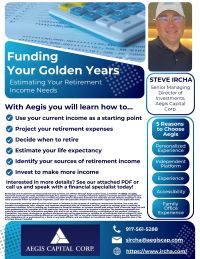Financial Corner: Changing Jobs? Know Your 401K Options

by Aegis Capital
July 13, 2025: If you've lost your job, or are changing jobs, you may be wondering what to do with your 401(k) plan account. It's important to understand your options.
What will I be entitled to?
If you leave your job (voluntarily or involuntarily), you'll be entitled to a distribution of your vested balance. Your vested balance always includes your own contributions (pre-tax, after-tax, and Roth) and typically any investment earnings on those amounts. It also includes employer contributions (and earnings) that have satisfied your plan's vesting schedule.
In general, you must be 100% vested in your employer's contributions after three years of service ("cliff vesting"), or you must vest gradually, 20% per year until you're fully vested after six years ("graded vesting"). Plans can have faster vesting schedules, and some even have 100% immediate vesting. You'll also be 100% vested once you've reached your plan's normal retirement age.
It's important for you to understand how your particular plan's vesting schedule works, because you'll forfeit any employer contributions that haven't vested by the time you leave your job. Your summary plan description (SPD) will spell out how the vesting schedule for your particular plan works. If you don't have one, ask your plan administrator for it. If you're on the cusp of vesting, it may make sense to wait a bit before leaving, if you have that luxury.
Don't spend it
While this pool of dollars may look attractive, don't spend it unless you absolutely need to. If you take a distribution you'll be taxed, at ordinary income tax rates, on the entire value of your account except for any after-tax or Roth 401(k) contributions you've made. And, if you're not yet age 55, an additional 10% penalty may apply to the taxable portion of your payout. unless an exception applies. (Special rules may apply if the lump-sum includes employer stock.)
If your vested balance is more than $7,000, you can leave your money in your employer's plan at least until you reach the plan's normal retirement age (typically age 65). But your employer must also allow you to make a direct rollover to an IRA or to another employer's 401(k) plan (if permitted by that plan). As the name suggests, in a direct rollover the money passes directly from your 401(k) plan account to the IRA or other plan. This is preferable to a "60-day rollover," where you get a check made payable to you and then roll the money over yourself, because your employer has to withhold 20% of the taxable portion of a 60-day rollover. You can still roll over the entire amount of your distribution, but you'll need to come up with the 20% that's been withheld until you recapture that amount when you file your income tax return.
Should I roll over to my new employer's 401(k) plan or to an IRA?
Assuming both options are available to you, there's no right or wrong answer to this question. You need to weigh all of the factors, and make a decision based on your own needs and priorities. It's best to have a professional assist you with this, since the decision you make may have significant consequences — both now and in the future.
Reasons to consider rolling over to an IRA:
-You generally have more investment choices with an IRA than with an employer's 401(k) plan. You typically may freely move your money around to the various investments offered by your IRA trustee, and you may divide up your balance among as many of those investments as you want. By contrast, employer-sponsored plans may offer a limited menu of investments from which to choose.
-You can freely allocate your IRA dollars among different IRA trustees/custodians. There's no limit on how many direct, trustee-to-trustee IRA transfers you can do in a year. This gives you flexibility to change trustees often if you are dissatisfied with investment performance or customer service. It can also allow you to have IRA accounts with more than one institution for added diversification. With an employer's plan, you can't move the funds to a different trustee unless you leave your job and roll over the funds.
-An IRA may give you more flexibility with distributions. Your distribution options in a 401(k) plan depend on the terms of that particular plan, and your options may be limited. However, with an IRA, the timing and amount of distributions are generally at your discretion (until you reach the age at which you must begin taking minimum distributions).
-You can roll over (essentially "convert") your 401(k) plan distribution to a Roth IRA. You'll generally have to pay taxes on the amount you roll over (minus any after-tax contributions you've made), but any qualified distributions from the Roth IRA in the future will be tax free. Reasons to consider rolling over to your new employer's 401(k) plan (or stay in your current plan).
-Many employer-sponsored plans have loan provisions. If you roll over your retirement funds to a new employer's plan that permits loans, you may be able to borrow up to 50% of the amount you roll over if you need the money. You can't borrow from an IRA — you can only access the money in an IRA by taking a distribution, which may be subject to income tax and penalties. (You can give yourself a short-term loan from an IRA by taking a distribution and then rolling the dollars back to an IRA within 60 days; however, this move is permitted only once in any 12-month time period).
-Employer retirement plans generally provide greater creditor protection than IRAs. Most 401(k) plans receive unlimited protection from your creditors under federal law. Your creditors (with certain exceptions) cannot attach your plan funds to satisfy any of your debts and obligations, regardless of whether you've declared bankruptcy. In contrast, any amounts you roll over to a traditional or Roth IRA are generally protected under federal law only if you declare bankruptcy.
Any creditor protection your IRA may receive in cases outside of bankruptcy will generally depend on the laws of your particular state. If you are concerned about asset protection, be sure to seek the assistance of a qualified professional.
-You may be able to postpone required minimum distributions. For traditional IRAs, these distributions must begin by April 1 following the year you reach age 73 (75 for those who reach age 73 after December 31, 2032). However, if you work past that age and are still participating in your employer's 401(k) plan, you can delay your first distribution from that plan until April 1 following the year of your retirement. (You also must own no more than 5% of the company).
-If your distribution includes Roth 401(k) contributions and earnings, you can roll those amounts over to either a Roth IRA or your new employer's Roth 401(k) plan (if it accepts rollovers). If you roll the funds over to a Roth IRA, the Roth IRA holding period will determine when you can begin receiving tax-free qualified distributions from the IRA. So if you're establishing a Roth IRA for the first time, your Roth 401(k) dollars will be subject to a brand new five-year holding period. On the other hand, if you roll the dollars over to your new employer's Roth 401 (k) plan, your existing five-year holding period will carry over to the new plan. This may enable you to receive tax-free qualified distributions sooner.
When evaluating whether to initiate a rollover always be sure to (1) ask about possible surrender charges that may be imposed by your employer plan, or new surrender charges that your IRA may impose, (2) compare investment fees and expenses charged by your IRA (and investment funds) with those charged by your employer plan (if any), and (3) understand any accumulated rights or guarantees that you may be giving up by transferring funds out of your employer plan.
What about outstanding plan loans?
In general, if you have an outstanding plan loan, you'll need to pay it back, or the outstanding balance will be taxed as if it had been distributed to you in cash. If you can't pay the loan back before you leave, you'll still have 60 days to roll over the amount that's been treated as a distribution to your IRA. Of course, you'll need to come up with the dollars from other sources.
IMPORTANT DISCLOSURES: Broadridge Investor Communication Solutions, Inc. does not provide investment, tax, legal, or retirement advice or recommendations. The information presented here is not specific to any individual's personal circumstances. To the extent that this material concerns tax matters, it is not intended or written to be used, and cannot be used, by a taxpayer for the purpose of avoiding penalties that may be imposed by law. Each taxpayer should seek independent advice from a tax professional based on his or her individual circumstances. These materials are provided for general information and educational purposes based upon publicly available information from sources believed to be reliable — we cannot assure the accuracy or completeness of these materials. The information in these materials may change at any time and without notice.
Aegis Capital Corp. Steve & Jane Ircha & Richard Palmadesso
Steven Ircha Senior Managing Director 26 Paxton Ave. 914-361-1099 This email address is being protected from spambots. You need JavaScript enabled to view it. https://www.ircha.com
Note: This content is sponsored by Aegis Capital.
Editor's note: As a public service, MyhometownBronxville publishes articles from local institutions, officeholders, and individuals. MyhometownBronxville does not fact-check statements therein, and any opinions expressed therein do not necessarily reflect the thinking of its staff.
Financial & Legal Assistance Directory
Hymes & Associates, CPA, P.C.
Our firm provides outstanding service to our clients because of our dedication to the three underlying principles of professionalism, responsiveness, and quality.
Listed as one of the 10 largest firms by The Westchester Business Journal, we serve clients throughout the tri-state area. By combining our expertise, experience, and
the energy of our staff, each client receives close, personal and professional attention.
Our high standards, service, and specialized staff spell the difference between our outstanding performance and other firms. We make sure that every client
is served by the expertise of our whole firm.
Hymes & Associates, CPA, P.C.
55 Pondfield Road
Bronxville, NY 10708
914-961-1200
914-961-1715 (Fax)
Website: www.hymescpa.com
Baillie & Hershman
44 Pondfield Road, Suite - 12
Bronxville, N.Y. 10708
Office: 914-337-6300
Matthew W. Kerner, ESQ.
Direct Dial: 914-337-6569
Email: This email address is being protected from spambots. You need JavaScript enabled to view it.
Fax: 914-337-6913
Suzanne M. Bloomer, Esq.
Direct Dial: 914-337-0142
This email address is being protected from spambots. You need JavaScript enabled to view it.
Baillie & Hershman provides comprehensive Real Estate legal services for buyers, sellers, current owners, real estate agents and lenders. We also handle estate planning, including the drafting of wills.
Griffin, Coogan, Sulzer & Horgan, P.C.
Attorneys and Counselors at Law
Griffin, Googan, Sulzer & Horgan, R.C.
Located in Bronxville, New York, Griffin, Coogan, Sulzer & Horgan, P.C. takes great pride in providing our clients with comprehensive, high quality legal services in a responsive manner. The firm concentrates its practice in real estate law with a primary focus on issues relating to real estate tax litigation (also known as tax certiorari), real estate transactions, valuation law, real property taxation and tax planning and real property tax exemption matters throughout New York State.
The firm serves as general counsel for several local cooperatives and represents clients in various issues relating to wills, trusts and estate planning.
51 Pondfield Road
Bronxville, NY 10708
(914) 961-1300
This email address is being protected from spambots. You need JavaScript enabled to view it.
Nobile, Magarian & DiSalvo LLP
We are hardworking and dedicated attorneys who, combined, have more than 150 years of experience delivering quality legal advice. Our cutting edge is our ability to enter both the conference room and the courtroom with strength. Our law firm provides legal representation and counsel for both individual and business clients on issues related to estate planning and administration, real estate law, litigation, and business law. Our practice areas include: Commercial Litigation, Business Law, Real Estate, Wills, Estate Planning, Trusts, Estate Administration, Living Wills, Health Care Proxies, Powers of Attorney, Not For Profits, and Employment Law.
111 Kraft Avenue
Bronxville, NY 10708
914-337-6300
Veneruso, Curto, Schwartz & Curto, LLP
Veneruso, Curto, Schwartz & Curto is dedicated to providing businesses and individuals with exceptional legal services customized to each client's needs and objectives. Practice areas include litigation, real estate, not for profit, wills and estate planning, land use and zoning, business and corporate, cooperative and condominium and real estate tax assessment litigation.
The Hudson Valley Bank Building
35 East Grassy Sprain Road, Suite 400
Yonkers, New York 10710
914-779-1100
Aegis Capital
Steve brings 40 years of investing experience to his role as Senior Managing Director at Aegis Capital Corp., a prominent national securities firm.



















